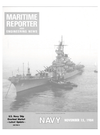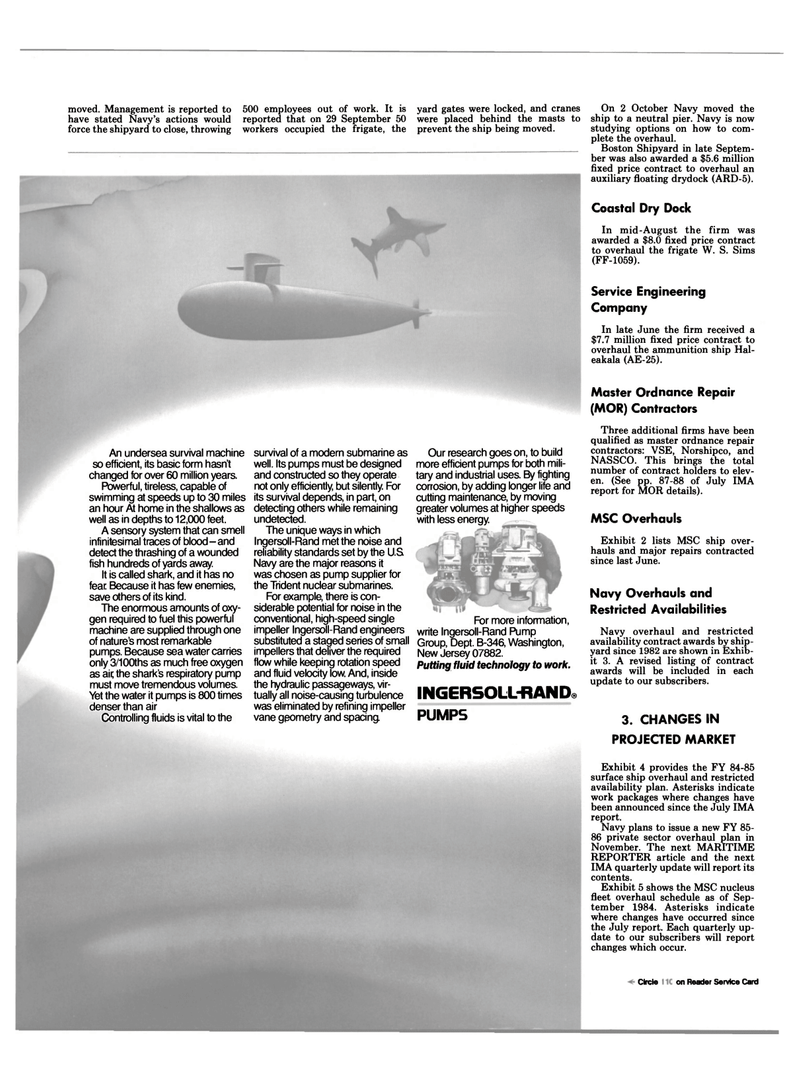
Page 19: of Maritime Reporter Magazine (November 15, 1984)
Read this page in Pdf, Flash or Html5 edition of November 15, 1984 Maritime Reporter Magazine
moved. Management is reported to have stated Navy's actions would force the shipyard to close, throwing 500 employees out of work. It is reported that on 29 September 50 workers occupied the frigate, the yard gates were locked, and cranes were placed behind the masts to prevent the ship being moved.
An undersea survival machine so efficient, its basic form hasn't changed for over 60 million years.
Powerful, tireless, capable of swimming at speeds up to 30 miles an hour At home in the shallows as well as in depths to 12,000 feet.
A sensory system that can smell infinitesimal traces of blood-and detect the thrashing of a wounded fish hundreds of yards away.
It is called shark, and it has no fear Because it has few enemies, save others of its kind.
The enormous amounts of oxy- gen required to fuel this powerful machine are supplied through one of nature's most remarkable pumps. Because sea water carries only 3/100ths as much free oxygen as air; the shark's respiratory pump must move tremendous volumes.
Yet the water it pumps is 800 times denser than air
Controlling fluids is vital to the survival of a modern submarine as well. Its pumps must be designed and constructed so they operate not only efficiently, but silently. For its survival depends, in part, on detecting others while remaining undetected.
The unique ways in which
Ingersoll-Rand met the noise and reliability standards set by the U.S
Navy are the major reasons it was chosen as pump supplier for the Trident nuclear submarines.
For example, there is con- siderable potential for noise in the conventional, high-speed single impeller Ingersoll-Rand engineers substituted a staged series of small impellers that deliver the required flow while keeping rotation speed and fluid velocity low. And, inside the hydraulic passageways, vir- tually all noise-causing turbulence was eliminated by refining impeller vane geometry and spacing
Our research goes on, to build more efficient pumps for both mili- tary and industrial uses. By fighting corrosion, by adding longer life and cutting maintenance, by moving greater volumes at higher speeds with less energy.
For more information, write Ingersoll-Rand Pump
Group, Dept. B-346, Washington,
New Jersey 07882.
Putting fluid technology to work.
INGERSOLL-RAND®
PUMPS
On 2 October Navy moved the ship to a neutral pier. Navy is now studying options on how to com- plete the overhaul.
Boston Shipyard in late Septem- ber was also awarded a $5.6 million fixed price contract to overhaul an auxiliary floating drydock (ARD-5).
Coastal Dry Dock
In mid-August the firm was awarded a $8.0 fixed price contract to overhaul the frigate W. S. Sims (FF-1059).
Service Engineering
Company
In late June the firm received a $7.7 million fixed price contract to overhaul the ammunition ship Hal- eakala (AE-25).
Master Ordnance Repair (MOR) Contractors
Three additional firms have been qualified as master ordnance repair contractors: VSE, Norshipco, and
NASSCO. This brings the total number of contract holders to elev- en. (See pp. 87-88 of July IMA report for MOR details).
MSC Overhauls
Exhibit 2 lists MSC ship over- hauls and major repairs contracted since last June.
Navy Overhauls and
Restricted Availabilities
Navy overhaul and restricted availability contract awards by ship- yard since 1982 are shown in Exhib- it 3. A revised listing of contract awards will be included in each update to our subscribers. 3. CHANGES IN
PROJECTED MARKET
Exhibit 4 provides the FY 84-85 surface ship overhaul and restricted availability plan. Asterisks indicate work packages where changes have been announced since the July IMA report.
Navy plans to issue a new FY 85- 86 private sector overhaul plan in
November. The next MARITIME
REPORTER article and the next
IMA quarterly update will report its contents.
Exhibit 5 shows the MSC nucleus fleet overhaul schedule as of Sep- tember 1984. Asterisks indicate where changes have occurred since the July report. Each quarterly up- date to our subscribers will report changes which occur.
Circle 296 on Reader Service Card

 18
18

 20
20
